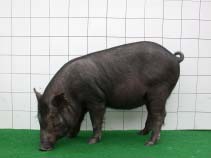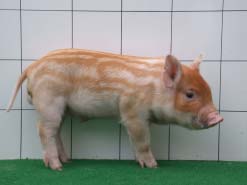SELECTION AND UTILIZATION OF INDIGENOUS MINI-PIG
H. P. Chu*
Taitung Animal Propagation Station, Livestock Research Institute, Taitung County, 95444
*Corresponding author, e-mail:
hpchu@mail.tlri.gov.tw
ABSTRACT
The indigenous mini-pig breed was introduced from Lanyu Islet for germplasm conservation and utilization. For the purpose of developing experimental pig breed, homotypic GPI-PGD line of Lanyu breed was established in 1992 with genotypes of GPI-BB and PGD-AA. Spotty Lanyu pig with recessive phenotype of coat was selected from conservation herd. Mitsai pig is a crossbreed of Lanyu and Duroc through coat color selection and inbreeding. The two breeds were registered as a formal pig breed in 2003. All breeding herds were investigated by molecular biological analysis for estimating the genetic variation in 2005. The results could be applied for population management and maintenance of genetic diversity in the future.
KEY WORDS: Lanyu Pig, Selection, Germplasm conservation.
ORIGIN OF LANYU PIG
Lanyu pig is an indigenous mini-pig breed. It originated from Lanyu Islet which locates at the south eastern Taiwan in the Pacific Ocean (Fig.1). It has small erect ears and and solid black coat color (Fig.2). Mini-pig is tolerable to local high temperature and high humidity. It has strong disease resistance capability. For conserving genetic resource and developing experimental pig breeds, four male and sixteen female Lanyu pigs were introduced into Taitung Animal Propagation Station in 1980 (TAPS, TLRI). The closed population was raised under random mating system to maintain its genetic diversity (Lee et al., 1994).


LANYU GPI-PGD INBRED LINE
The genetic markers, such as GPI (Glucose phosphate isomerase) and PGD (6-Phosphogluconate dehydrogenase) alleles, have been proved to have codominance. Due to the two loci locating closely at the chromosome 6, the markers are usually used as an important index for selection of a new breed or line. The different GPI genotype of Lanyu pigs were used for mating experiments. The results showed that the major genotype of offspring and the 60-day old fetuses from heterotypic, GPI-AB, parents was GPI-BB, and there was no A allele fetus found, part of GPI-AB fetuses appeared mummified or inactive. Therefore, the B allele was considered to have good reproductive performance than A allele. The homotypic GPI-PGD line of Lanyu breed of pigs was established in 1992 with genotypes of GPI-BB and PGD-AA (Shiue et al., 1993). After two generations of inbreeeding, the number of piglet born alive per litter was not affected by the half-sib mating with 14.1% inbreeding coefficient (Chen et al., 1999). Therefore, full-sib mating was conducted and selection for four generations was conducted so far. This pig is going to register as a formal inbred line these days.
SPOTTY LANYU PIG BREED(LANYU 100)
Lanyu is a native pig breed with a solid black coat color. The conservation herd has been under random mating since 1982. Piglets with white spots (Fig.3) were observed from conservation herd in 1993 and the individuals were screened to avoid possible lethal genetic factors. After investigations on the reproductive performances and test-cross experiment, there was no observed negative effect. The spotty phenotype was validated to be a recessive inheritance (Lee et al., 1998). Selection of spotty Lanyu pig was launched by one generation per year since 1993. From 1994 to 1999, half-sib mating was conducted and the full-sib mating was applied to establish a higher inbreeding line (Lee et al., 1999). It was registered as a formal pig breed (Fig.4) in June 2003 (Lee et al., 2003). By inbreeding, more uniform performances in many genetic traits were achieved, it could be used as a laboratory animal for biomedical researches.
Figure 2. Lanyu pig (5 months old)
Figure 1. Map of Taiwan, showing the locations of Lanyu islet and TAPS.


MITSAI PIG BREED(LANYU 50)
Mitsai pig is a crossbreed of Lanyu and Duroc pig. Through coat color selection and inbreeding, 65% of hybrid piglets had several brown and black stripes longitudinally on their coat (Table 1), and 7.5% of F2 piglets from brown and black stripes parents exhibited brown-white stripes. The selection program for brown-white stripping phenotype was launched in 1992 with six male and 18 female pigs for each generation and for each year. Experimental results were as follows: 72.8% of F4 piglets exhibited brown-white stripes as compared to 25.3% in F3, which increased almost threefold. All F6 piglets exhibited brown-white stripes (Wu et al., 1999). Brown-white stripping is a kind of juvenile coat color and will fade gradually when pigs reached the mature age. Full-sib mating was applied to establish an inbred line, and was registered as a formal pig breed (Lanyu 50) in June 2003 (Lee et al., 2003).The gene for brown-white stripping was postulated to be a recessive gene. For the economical consideration, the Mitsai breed could be used as ornamental pig for recreation and laboratory animal for biomedical researches.
Figure 4. Spotty Lanyu pig (5 months old).
Figure 3. Spotty piglets found in Lanyu pig’s offspring.
Table1. Frequencies of piglet with coat color of longitudinal stripes at different generations(Wu et al., 1999)
|
| | Coat color with its frequency(%) |
Generation | N | Brown-black strip | Brown-white stripes | Solid black | Solid Brown | With spots |
Duroc (D) | 9 | 0.0 | 0.0 | 0.0 | 100.0 | 0.0 |
Lan-yu (M) | 7 | 0.0 | 0.0 | 100.0 | 0.0 | 0.0 |
F1 D× M
| 40 | 65.0 | 0.0 | 2.5 | 0.0 | 32.5 |
F1 M× D
| 35 | 80.0 | 0.0 | 0.0 | 0.0 | 20.0 |
F2 (parity 1 and 2)
| | | | | | |
DM × DM | 40 | 45.0 | 12.5(5)a
| 27.5 | 12.5 | 2.5 |
MD × DM | 40 | 40.0 | 5(2) | 32.5 | 7.5 | 15.0 |
DM × MD | 45 | 46.7 | 13.3(6) | 26.7 | 4.4 | 8.9 |
MD × MD | 57 | 33.3 | 7(4) | 49.2 | 10.5 | 0.0 |
F2 (parity 3 and 4)
| 145 | 31.0 | 7.5(11) | 43.5 | 18.0 | 0.0 |
F3
| 217 | 41.5 | 25.3(55) | 1.4 | 31.8 | 0.0 |
F4
| 114 | 21.1 | 72.8(83) | 1.7 | 4.4 | 0.0 |
F5
| 185 | 0.0 | 91.9(170) | 0.0 | 8.1 | 0.0 |
F6
| 130 | 0.0 | 100.0(130) | 0.0 | 0.0 | 0.0 |
a Number in parentheses was the number of pigs with white and brown stripes |
b Sows were mated by boars which they had progeny with and brown stripes from parity 1 and 2 of sows |

Figure 5. Mitsai pig (8 weeks old).
THE PHYLOGENETIC STUDY OF LANYU PIG BY MICROSATELLITE MARKERS
The aim of this project is to investigate the phylogeny of the Lanyu pig conservation herd and assess the degree of inbreeding depression which may occur in closed population that has been maintained over 20 years. The molecular biological techniques were used to analyze genetic variation and genetic distance in each individual of the conservation herd. A total of twenty five microsatellite markers which published at the Domestic Animal Diversity Information System of Food and Agriculture Organization in United Nations were synthesized. After using software CERVUS to analyze genotype data, the average heterozygosity of Lanyu pig population is 0.384. The standard genetic distances between thirty-nine Lanyu pigs were calculated by the software of MSA and the UPGAM method was used to construct the genetic relationship tree based on the standard genetic distance. This well-established genetic relationship of Lanyu pigs could be applied for population management in the future (You et al., 2004).
REFERENCE
Chen, W. C., C. J. Lee, J. L. Tzeng, H. L. Chang and M. C. Wu. 1999. Litter Size of the Homozygotic GPI-PGD Line in Lanyu Pigs with Half-sib Mating. J. Taiwan Livestock 7.
Lee, C. J., H. P. Chu, H. L. Chang, M. C. Wu, K. J. Chen and J. C. Huang. 2003. The selecting and registration of Mitsai pig (Lanyu 50). J. Chin. Soc. Anim. Sci. 32 (4):131.
Lee, C. J., W. C. Chen, J. L. Tzeng, H. L. Chang and M. C. Wu. 1994. Analysis of litter size in a population at random mating of Lanyu breed sows. J. Taiwan Livestock Res. 27(2):109~117.
Lee, C. J., W. C. Chen, J. L. Tzeng, H. L. Chang and M. C. Wu. 1998. Selection of pig coat color for white- and brown-spotting in Lanyu inbreeding line. J. Chin. Soc. Anim. Sci. 27 (4):485~497.
Lee, C. J., M. C. Wu, W. C. Chen, J. L. Tzeng and H. L. Chang. 1999. Body conformation of the inbreeding spotty Lanyu pigs and their first litter sizes. J. Chin. Soc. Anim. Sci. 28 (4):451~459.
Lee, C. J., H. P. Chu, H. L. Chang, M. C. Wu, K. J. Chen and J. C. Huang. 2003. The selecting and registration of Spotty Lanyu pig (Lanyu 100). J. Chin. Soc. Anim. Sci. 32 (4):132.
Shiue, Y. L., C. J. Lee and M. C. Wu. 1993. The reproductive superiority of allele B in PHI locus in Lanyu pig. J. Chin. Soc. Anim. Sci. 22 (suppl):122.
Wu, M. C., C. J. Lee, J. L. Tzeng, W. C. Chen and H. L. Chang. 1999. Mitsai, a miniature pig selection for ornamental and recreation purposes. J. Chin. Soc. Anim. Sci. 28 (2):173~183.
You, Y. T., C. Y. Wu, P. H. Wang, H. P. Chu, K. J. Chen, Y. T. Ju and J. C. Huang. 2004. Phylogenetic relationships of small-ear and exotic swine breeds. J. Chin. Soc. Anim. Sci. 33 (suppl):118.